James Kennedy
-
- There’s an App for That! Marine Technology, Mar 2014 #38
Protect your unmanned investment, operate multiple systems, mix and match services Plug-and-play capabilities for unmanned systems?
Scientists have long recognized the value of unmanned systems as tools to conduct exploration and research. The advantages are many, and the cost is usually less than would be incurred for a research ship or manned aircraft mission.
Original equipment manufacturers (OEMs) who make unmanned underwater vehicles (UUVs), unmanned surface vehicles (USVs), and unmanned aerial vehicles (UAVs) usually provide the vehicle, control station, software and communication protocols, which are almost always unique to that system.
As technology and the market mature, there is a growing demand for flexibility to adapt systems for different missions, operate different systems from a common control station and upgrade them easily when new and innovative applications become available.
While the armed forces are leading the way, commercial, academic, homeland security, law enforcement and other users of unmanned systems can benefit, too.
“We’ve standardized the means of controlling and communicating between the ground and the bird and all of the systems involved. The standard that we’re working on is called the Unmanned Aircraft Systems (UAS) Control Segment, or UCS, and it is hardware independent,” said Rich Ernst, who leads the USC architecture development in DoD.”
All systems do not necessarily use the same functions, but with many systems you have to accept what functions the OEM provides. Some are simple, and others complex. Some systems give you more than you really need, and some not quite enough. With UCS, you can now mix and match applications, using only what you need, and you can take advantage of new applications as they become available.
“We can identify specific requirements and create applications that meets that requirement, or closes the gap,” said Ernst.
“We’ve been limited by the fact that OEMs have different approaches with different hardware, software, processes and interfaces—different everything,” said Ernst. “That’s what we’re trying to avoid.”
“UCS ensures that the interface standard is known to all vendors so we don’t have proprietary interface standards where only the OEM can add or subtract to it without significant cost growth,” said Lt. Col. James Kennedy, Product Manager Common Systems Integration with the Unmanned Aircraft Project Office, PEO Aviation at Redstone Arsenal, Alabama. “We typically end up having to go back to the same vendor who wrote the software initially to add capability. UCS repackages that software into an open standard that is well-known, that isn’t commercialized, that industry recognizes and thereby opens our competition and it opens the ability for third parties to add capability.”
“Our vision is an architecture that is flexible enough to range from our small UAS and OSRVT (One System Remote Video Terminal), through our large UAS and the ground control station,” said Kennedy.
According to Ernst, UCS breaks up the different ground control segment functionalities, which allows for insertion of new capabilities and upgrading of legacy capabilities—such as route planning, weather services, task monitoring or flight status monitoring that most GCS have to implement—without having to rebuild the entire GCS. “It’s ‘plug and play’ for GCS development.”
Legacy systems can be adapted for UCS, and are then able to take advantage of the many benefits of UCS. This helps to protect an investment in a system, and can prolong the service life of the system by adding new capability.
The software from the Army Bi-Directional Remote Video Transceiver (BDRVT), which is an enhanced version of the Army’s One System Remote Video Transceiver (OSRVT) (made by AAI Corporation to support video and telemetry from a number of UAS such as Shadow, Predator, Pioneer and others), was used to demonstrate how UCS works.
One experiment was conducted by the Navy. “BDRVT was totally integrated software,” said Wayne Perras, UCS project manager at the Office of Naval Research (ONR). “We broke it up into services and rewrote those services into UCS in two different codes. Then we combined the services back together again to see if we can have that same BDRVT to prove that that it operates vehicles.”
“We showed that we’ve got interoperability by having it built and written in a different code, and being able to exchange or replace services while continuing to operate at the same performance,” Perras said.
Then the Army flight-tested the UCS-compliant BDRVT with an AAI Corporation Shadow reconnaissance UAS.
“We took a bidirectional capability, put it into an open architecture model which was compliant with the UCS standards and demonstrated that the open model could, in fact, address the bidirectional capability that we’re looking to put into our systems,” said Kennedy.
The flight-test using an Army Shadow UAS was a success. “It was so successful that we have moved our whole OSRVT architecture to be compliant with those open standards,” Kennedy said. “This allows us to more readily connect the applications that third parties may have developed, whether it’s Garmin or third-party contractor developed applications that plug into our known standard, thereby reducing the cost of integration for the program overall. It also allows us to introduce competition into the program, because now we don’t have to keep going back to the same vendor in order to add capabilities. We can compete and allow other vendors to be able to develop those applications—as long as they’re applying those standards that are embedded due to UCS and open architecture—so the integration cost is less. So it was a very successful demo and it’s caused us to really focus our OSRVT around that open architecture standard.”
“Legacy GCS systems can naturally transition to using the UCS architecture. This simplifies the integration of legacy systems, since, in large part, UCS was designed from the ground up to ensure that the needs of legacy systems were analyzed and incorporated,” Ernst said.
Adapting existing software incurs a cost, but that cost can have a significant return on investment.
Ernst said that there are many industry best practices for developing modular software. UCS has chosen a “functional decomposition,” which breaks apart GCS capabilities based on common functions (e.g. route planning, weather monitoring, task monitoring, flight status monitoring, etc.) that most GCS have to implement.
This is benefiting the Navy today as it develops the UCS-based common control system (CCS) for the Unmanned Carrier Launched Airborne Surveillance and Strike — or UCLASS. A control station built to the UCS model could conceivably fly other Navy UAS, like Triton, Fire Scout or Scan Eagle, as well as other unmanned systems in other domains.
“It makes it easier to bring in the best of breed,” said Kevin Davis, program manager requirements officer for the common control system and common standards and interoperability (OPNAV N2 / 6 F2). “If you have two apps that do relatively the same thing, we can have the warfighter determine which one they like best. If they have different, multiple weather apps or something, you could bring in those, test them out and see which one they like best and go with that one. It really helps out.”
“We’re not mature enough yet throughout our different systems to fly everybody’s air vehicles, but that’s where we’re headed,” said Jeff Davis, deputy program manager for CCS in the strike planning and execution systems program office at Naval Air Systems Command (NAVAIR PMA 281).
UCS is more than a technology-architecture; it’s an open business model that allows small businesses to compete on an even playing field.
“It’s a huge paradigm shift for us to be able to go out to multiple vendors and buy pieces and components of the system,” Davis said.
“The faster that we show we can integrate those applications and get them out to users, it encourages industry to start building the better widget, and a lot of people will start getting involved in that market,” said Jeff Davis.
And that’s what it will become: a market. Ernst called it an “ecosystem that goes beyond the typical technical and business structure.”
It’s bigger than the military—other users, like the S&T community—will drive that market, too.
Ernst said that when new UCS-compliant applications are developed, they will be made available through an online “app store” repository. The best apps will be in demand, creating a market that will stimulate innovation.
“Even within the individual military services, nobody has situational awareness of what everybody’s building and the opportunities for reuse,” said Ernst. “There now is transparency, with a marketplace to go and look at products that can be leveraged. You might not find exactly what you want, but it helps identify products that are very close to what you want and you just go to the vendor and work with them to modify the existing product to meet your requirement.”
“We talk about getting a common architecture defined for everybody. Well, here it is. That’s the power of UCS architecture,” said Jeff Davis. “And we’ve got to start thinking that way.”
To learn more about the UCS architecture and how you can both adapt your system to be UCS compliant and develop applications for use across the spectrum of UCS-compliant systems, visit
www.ucsarchitecture.org(As published in the March 2014 edition of Marine Technology Reporter - www.seadiscovery.com)
-
 )
March 2024 - Marine Technology Reporter page: 36
)
March 2024 - Marine Technology Reporter page: 36at a rate lower than 1C. (See Lander Lab #5, MTR, November/December 2022) Lead-acid wet-cells must remain upright or the electrolyte, a On March 26, 2012, James Cameron’s DEEPSEA CHAL- 35% sulphuric acid and 65% water solution, will spill. They LENGER submersible and ocean lander DOV MIKE demon- can be exposed
-
 )
March 2024 - Marine Technology Reporter page: 35
)
March 2024 - Marine Technology Reporter page: 35high and weight low, WHOI’s SeaBED AUV captures the attention of a pair of curious Antarctic penguins as it is deployed from the British research vessel James Clark Ross. Vehicle designers allowed for temperature reduction of battery capacity. Rechargeable batteries may be put on trickle chargers to pre-
-
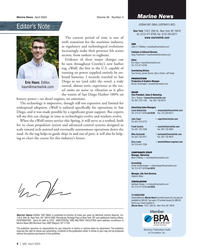 )
April 2024 - Marine News page: 4
)
April 2024 - Marine News page: 4new harbor Tel: 212-477-6700 tug, eWolf, the ? rst in the U.S. capable of Contributing Writers running on power supplied entirely by on- Tom Ewing, James Kearns, Barry Parker, Jeff Vogel board batteries. I recently traveled to San PRODUCTION Production & Graphics Manager Diego to see (and ride)
-
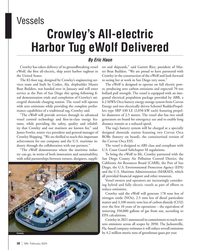 )
February 2024 - Marine News page: 38
)
February 2024 - Marine News page: 38distance transits at a reduced speed. ity that Crowley and our mariners are known for,” said The tug’s battery system will be charged at a specially James Fowler, senior vice president and general manager of designed shoreside station featuring two Corvus Orca Crowley Shipping. “We are thrilled to reach
-
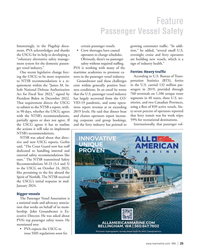 )
February 2024 - Marine News page: 25
)
February 2024 - Marine News page: 25said these challenges portation Statistics (BTS), ferries to NTSB recommendations is a re- in the U.S. carried 132 million pas- quirement within the “James M. In- exist within generally positive busi- hofe National Defense Authorization ness conditions. In an email he wrote sengers in 2019, provided
-
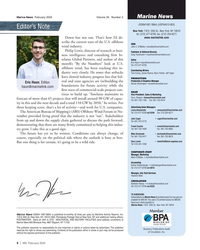 )
February 2024 - Marine News page: 4
)
February 2024 - Marine News page: 4look at U.S. Tel: 212-477-6700 offshore wind, has been tracking this in- Contributing Writers dustry very closely. He notes that setbacks Tom Ewing, James Kearns, Barry Parker, Jeff Vogel have slowed industry progress but that fed- PRODUCTION Production & Graphics Manager eral and state agencies
-
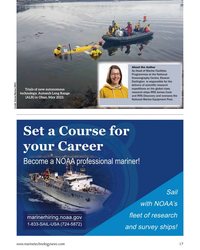 )
January 2024 - Marine Technology Reporter page: 17
)
January 2024 - Marine Technology Reporter page: 17Darlington is responsible for the delivery of scienti? c research expeditions on the global class Trials of new autonomous research ships RRS James Cook technology, Autosub Long Range and RRS Discovery and oversees the (ALR) in Oban, May 2023. National Marine Equipment Pool. Credit: Rachel
-
 )
January 2024 - Marine Technology Reporter page: 16
)
January 2024 - Marine Technology Reporter page: 16INSIGHTS SCIENCE RESEARCH MANAGEMENT Map of NOC vessel operations from April 2022 – March 2023. Green = RRS James Cook, Blue = RRS Discovery Credit: NOC bon output, with an ambition of reaching net zero by 2040. MFP to be able to undertake the same project management and international collaboration.
-
 )
January 2024 - Marine Technology Reporter page: 14
)
January 2024 - Marine Technology Reporter page: 14ice edges. As operators of two global class re- tion of instruments, personnel capabilities, and budget manage- search vessels (RRS Discovery and RRS James Cook) along- ment. NOC developed the Marine Facilities Planning (MFP) tool side the National Marine Equipment Pool (NMEP), NOC is a in collaboration
-
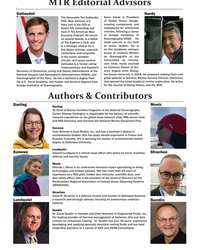 )
January 2024 - Marine Technology Reporter page: 6
)
January 2024 - Marine Technology Reporter page: 6Oceanography Center, Eleanor Darlington is responsible for the delivery of scienti? c research expeditions on the global class research ships RRS James Cook and RRS Discovery and oversees the National Marine Equipment Pool. Konowe Celia Konowe is from Reston, Va., and has a bachelor’s degree in
-
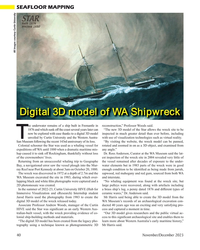 )
November 2023 - Marine Technology Reporter page: 40
)
November 2023 - Marine Technology Reporter page: 40SEAFLOOR MAPPING All images courtesy Curtin University Digital 3D model of WA Shipwreck he underwater remains of a ship built in Fremantle in reconstruction,” Professor Woods said. 1876 and which sunk off the coast several years later can “The new 3D model of the Star allows the wreck site to be now be
-
 )
November 2023 - Marine News page: 44
)
November 2023 - Marine News page: 44Length: 525 ft. Breadth: 88.5 ft. Feature Depth: 55.1 ft. Draft, design: 21.4 ft. Range: 10,000+ miles @ 18 knots Propulsion: Diesel Electric Great Vessels of 2023 Engines: Wabtec (4) separated in two engine rooms MARAD Total installed power: 16,800 kW Emergency generator: 900kW Electric propulsion
-
 )
November 2023 - Marine News page: 18
)
November 2023 - Marine News page: 18Column Legal Beat Bringing the Capital Construction Fund Program Ashore By James Kearns, Special Council, Jones Walker LLP On May 5, 2023, base amount, providing a total of more than $662 million the White House announced that the Environmental Pro- for FY 2023. The NOFOs that have been issued for
-
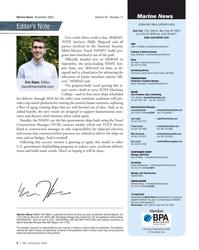 )
November 2023 - Marine News page: 4
)
November 2023 - Marine News page: 4NSMV, Em- Tel: 212-477-6700 pire State, was “delivered on time, as de- Contributing Writers signed and at a ? xed price for advancing the Tom Ewing, James Kearns, Barry Parker, Jeff Vogel education of future merchant marine of? - PRODUCTION Production & Graphics Manager cers,” MARAD said. Eric
-
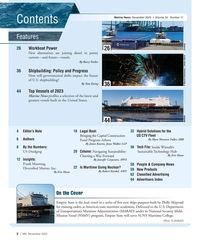 )
November 2023 - Marine News page: 2
)
November 2023 - Marine News page: 2for the Bringing the Capital Construction US CTV Fleet By Myra Shannon Fuller, ABB 6 Authors Fund Program Ashore By James Kearns, Jones Walker LLP 8 By the Numbers: 56 Tech File: Inside Wärtsilä’s US Dredging 20 Column: Navigating Sustainability:
-
 )
November 2023 - Maritime Reporter and Engineering News page: 23
)
November 2023 - Maritime Reporter and Engineering News page: 23systems do not have in supply chains until the shock of the Covid pandemic, said open APIs to integrate them. It could take up to 20 emails to James Pomeroy at HSBC, but that had changed now. order one spare part, he said. The last 12 months had seen a period of inventory rebuild- Seafarers, who
-
 )
November 2023 - Maritime Reporter and Engineering News page: 22
)
November 2023 - Maritime Reporter and Engineering News page: 22future changes.” Managing Director, Oceanly, included Peter Schellenberger, Empowerment of vessel control centers is also necessary Founder of Novamaxis, James Pomeroy, Global Economist, to achieve ef? ciency gains, he added, and “will drive mean- HSBC; and Marco Cristoforo Camporeale, Senior Director,
-
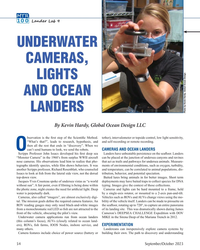 )
September 2023 - Marine Technology Reporter page: 54
)
September 2023 - Marine Technology Reporter page: 54, to capture an entire panorama from a monochromatic red LED so ? sh are not attracted to the of its landing site. This was dramatically shown during James front of the vehicle, obscuring the pilot’s view. Cameron’s DEEPSEA CHALLENGE Expedition with DOV Underwater camera applications run from ocean
-
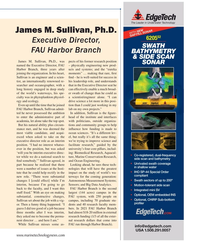 )
September 2023 - Marine Technology Reporter page: 35
)
September 2023 - Marine Technology Reporter page: 35James M. Sullivan, Ph.D. WITH NEW GAP FILL SONAR S2 6205 Executive Director, SWATH FAU Harbor Branch BATHYMETRY & SIDE SCAN James M. Sullivan, Ph.D., was pects of his former research position SONAR named the Executive Director, FAU – physically engineering new prod- Harbor Branch, three years after
-
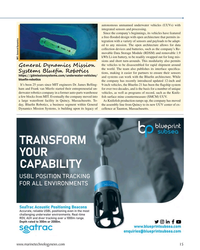 )
September 2023 - Marine Technology Reporter page: 15
)
September 2023 - Marine Technology Reporter page: 15the Blue? n architecture. While blue? n-robotics the company has recently introduced updated 12-inch and It’s been 25 years since MIT engineers Dr. James Belling- 9-inch vehicles, the Blue? n-21 has been the ? agship system ham and Frank van Mierlo started their entrepreneurial un- for over two decades
-
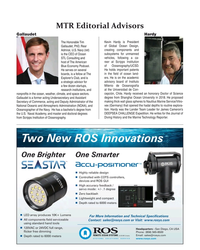 )
September 2023 - Marine Technology Reporter page: 7
)
September 2023 - Marine Technology Reporter page: 7that opened the hadal depths to routine explora- Oceanographer of the Navy. He has a bachelor’s degree from tion. Hardy was the Lander Team Leader for James Cameron’s the U.S. Naval Academy, and master and doctoral degrees DEEPSEA CHALLENGE Expedition. He writes for the Journal of from Scripps Institution
-
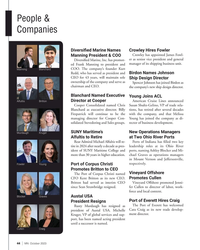 )
October 2023 - Marine News page: 44
)
October 2023 - Marine News page: 44People & Companies Diversi? ed Marine Names Crowley Hires Fowler Crowley has appointed James Fowl- Manning President & COO er as senior vice president and general Diversi? ed Marine, Inc. has promot- ed Frank Manning to president and manager of its shipping business unit. COO. The company’s founder
-
 )
October 2023 - Marine News page: 4
)
October 2023 - Marine News page: 4Haun • [email protected] Tel: 212-477-6700 • Biden’s Offshore Wind Target Slipping Out of Reach as Projects Struggle Contributing Writers Tom Ewing, James Kearns, Barry Parker, Jeff Vogel • BOEM Postpones Oil and Gas Lease PRODUCTION Sale 261 Production & Graphics Manager Eric Haun, Editor
-
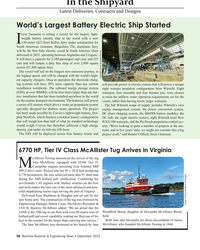 )
September 2023 - Maritime Reporter and Engineering News page: 58
)
September 2023 - Maritime Reporter and Engineering News page: 58, making our ? eet one of the ? eld. best in the country for the larger ships entering into service.” Both Jane and Alexandra are direct descendants of James The Jane McAllister was christened at her launch by Jane McAllister, who founded McAllister Towing in 1864. 58 Maritime Reporter & Engineering News
